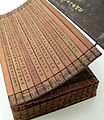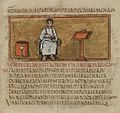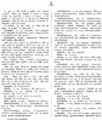Book facts for kids
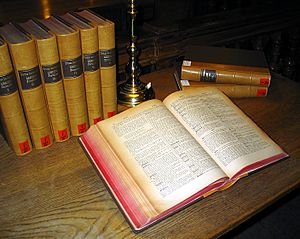
A book is a collection of printed pages. These pages are made of paper and held together by a cover. Books usually have text, language, and illustrations. This is their main purpose.
The person who writes a book is called an author. Someone who draws pictures in a book is called an illustrator. Sometimes, a book can have more than one author or illustrator.
A book can also mean a specific text that is part of a bigger collection. For example, the Bible or the Iliad are made of several "books." Encyclopedias often have articles by different people. These are published in different volumes, and each volume is a book.
Hardcover books have strong covers. These covers are made of cardboard and covered in cloth or leather. Their pages are usually sewn together. Paperback books have softer covers. These are made of stiff paper. Their pages are usually glued together. You can read words in books, or listen to them as audiobooks. Audiobooks are on tapes or compact discs.
You can borrow books from a library. You can also buy them from a bookstore. People can even make their own books. They might fill them with family photos, drawings, or their own stories. Some books are mostly empty inside. Examples are a diary, an address book, or a photo album. But usually, a "book" means it has words printed or written on its pages.
Some books are written just for children. Others are for entertainment, like fiction stories. Many books are for studying subjects in school. These include math or history. Many books include photographs or drawings to help explain things.
People who cannot read any kind of writing are called illiterate.
Contents
What Kinds of Books Are There?
Books generally come in two main types: fiction and non-fiction.
Understanding Fiction Books
These books are often novels or short stories. They tell tales that are made up. The author imagines these stories. Some fiction books might be inspired by real events. But the characters or conversations are created by the author.
Exploring Non-fiction Books
Non-fiction books are all about true facts. They cover things that have actually happened. Examples include dictionaries and cookbooks. Also, textbooks used for school are non-fiction. A biography (someone's life story) is another example.
How Books Have Changed Over Time
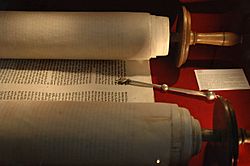
Before books were common, people used handwritten documents. These were called manuscripts. Books changed a lot thanks to several important inventions.
Early Manuscripts and Scrolls
One common manuscript was the scroll. This was a long sheet of material rolled up. These sheets could be made from papyrus. The Egyptians made papyrus from a plant. Other materials were parchment or vellum. These were very thin animal skins. The ancient Greeks first used them. Paper, made from plant fibers, was invented by the Chinese. Turning these scrolls into books needed new ideas.
The Invention of the Codex
The Romans were the first to put separate pieces of manuscript between covers. They called this a codex. A codex was much easier to handle and store than scrolls. But it was not quite a book as we know it today.
The Rise of Printing
Scrolls and codices were all copied by hand. This took a very long time. The Chinese invented woodblock printing. Designs were carved into wood blocks. Then they were inked and pressed onto paper. This method was still slow. So, very few people had books.
In the 15th century, Johannes Gutenberg invented the printing press. This machine used movable metal letters. These letters could be arranged and reused for printing.
At first, these machines were slow. A person had to operate them. Fast, automatic printing machines appeared later. They came out in the 19th century.
Paper and Ink Improvements
Paper was invented in the 8th century. But handmade paper was expensive and hard to get. In the 19th century, new methods were developed. Machines started making paper from wood pulp. This made paper much cheaper and widely available. Also, new inks were invented for different printing needs. Machines also started to be powered by electricity.
With cheaper paper and faster printing, books became much more affordable. This meant ordinary people could finally buy books. Around the same time, public libraries became popular. This gave even poorer people access to many books. Also, more people learned to read. Education became more widespread and often free.
How Books Are Put Together (Binding)
Printing was done on large sheets of paper. These sheets were then folded and cut. A guillotine was used for cutting. Then, they were sewn together in sections. Finally, these sections were placed into the covers. All these steps also became machine-driven during the 19th century.
Books Today
Today, some technologies for making books have changed. This is especially true for illustration and typography. Typography is the art of arranging type. However, books still look similar to how they did in the past. They now have more color illustrations. This is because readers prefer books designed in certain ways. This makes reading enjoyable. Graphic design and typography make books look good and easy to read.
Digital Printing for Books
New ways of making books include digital printing. This works a lot like an office copier. It uses toner instead of ink. Each book can be printed in one go. It is not printed in separate sections. Digital printing allows for much smaller numbers of books to be printed. This is great for special orders. For example, large print runs might use big web presses. Digital presses are often used for smaller runs. This has made "print-on-demand" possible. Books are only printed after a customer orders them. This helps reduce waste.
E-books: Books on Screens
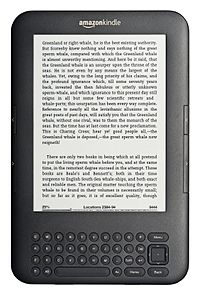
In the 2000s, handheld devices became common and affordable. Sharing texts electronically became popular for publishers. This led to the "e-book." The term e-book is short for "electronic book." It means a book-length publication in a digital format. E-books are usually available online. You can also find them on things like CD-ROMs. You can read e-books on a computer. Or you can use a special portable device. This is called an e-book reader. Examples are the Sony Reader or the Amazon Kindle. These devices are designed to feel like reading a physical book.
Paper and Keeping Books Safe

Paper was first made in China around 200 BC. It came to Europe through Muslim lands. At first, paper was made from rags. But the Industrial Revolution changed how paper was made. It allowed paper to be produced from wood pulp. Papermaking in Europe began in the 11th century. Vellum (animal skin) was also common for pages. It was used until the early 16th century. Vellum was more expensive and lasted longer. Printers sometimes offered the same book on both materials. This was to reach different buyers.
Paper made from wood pulp became popular in the early 20th century. It was cheaper than paper made from linen or abaca cloth. This cheaper pulp paper made books more affordable for everyone. This led to a huge increase in readers in industrial countries. It also helped spread information during the Second Industrial Revolution.
However, pulp paper often contains acid. This acid slowly destroys the paper from the inside. Older methods of making paper used limestone rollers. These helped remove the acid. Books printed between 1850 and 1950 are most at risk of decay. More recent books are often printed on acid-free or alkaline paper. Today, libraries sometimes use special treatments. These are called mass deacidification. They save older collections from falling apart.
Keeping the climate stable is very important for preserving paper and books. Good air circulation helps keep the temperature and humidity steady. Library buildings need modern heating, ventilation, and air conditioning (HVAC) systems. Light can also damage collections. So, libraries control the amount of light books are exposed to. Regular cleaning and pest control also help. Besides these daily efforts, libraries must be ready for unexpected disasters. These include floods or fires. They need a clear emergency management plan. This plan helps deal with any damage.
Related Topics
Images for kids
-
The Gutenberg Bible, one of the first books to be printed using the printing press.
-
Book of the Dead of Hunefer; c. 1275 BC; ink and pigments on papyrus; 45 × 90.5 cm; British Museum (London)
-
The Codex Amiatinus anachronistically depicts the Biblical Ezra with the kind of books used in the 8th Century AD.
-
Bagh print, a traditional woodblock printing technique that originated in Bagh Madhya Pradesh, India.
-
Selected Teachings of Buddhist Sages and Son Masters, the earliest known book printed with movable metal type, printed in Korea, in 1377, Bibliothèque nationale de France.
-
The spine of the book is an important aspect in book design, especially in the cover design. When the books are stacked up or stored in a shelf, the details on the spine is the only visible surface that contains the information about the book. In stores, it is the details on the spine that attract a buyer's attention first.
-
A page from a dictionary
-
An atlas
-
A telephone directory, with business and residence listings.
-
Paperback books
-
The Library of Celsus in Ephesus, Turkey was built in 135 AD, and could house around 12,000 scrolls.
-
Halfbound book with leather and marbled paper.
See also
 In Spanish: Libro para niños
In Spanish: Libro para niños



